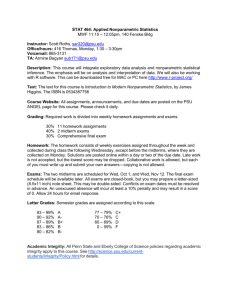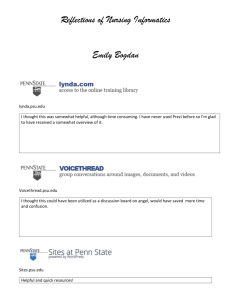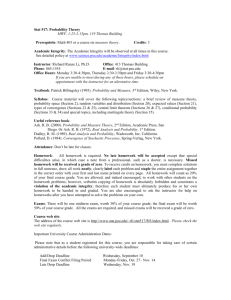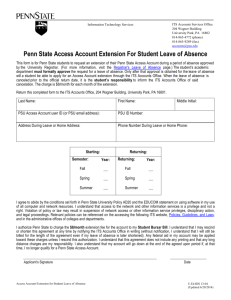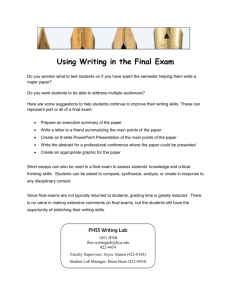Machine Design – MET 210W
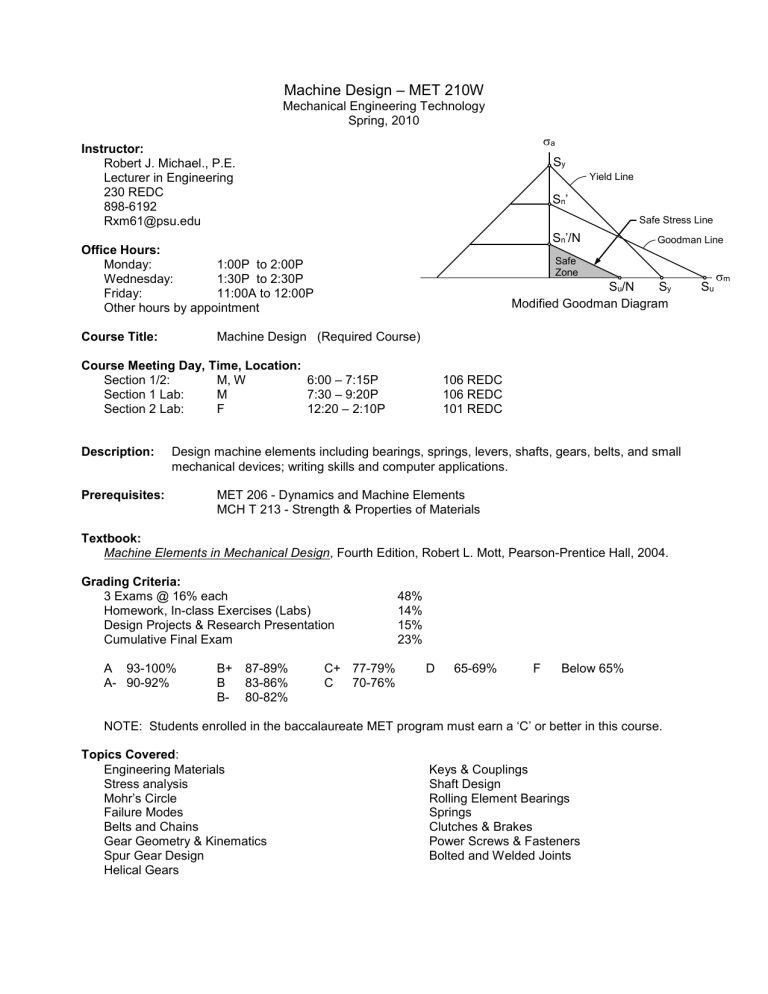
Machine Design
– MET 210W
Mechanical Engineering Technology
Spring, 2010
Instructor:
Robert J. Michael., P.E.
Lecturer in Engineering
230 REDC
898-6192
Rxm61@psu.edu
Office Hours:
a
S
S
S y n n
’
’/N
Yield Line
Safe Stress Line
Goodman Line
Monday:
Wednesday:
Friday:
1:00P to 2:00P
1:30P to 2:30P
11:00A to 12:00P
Safe
Zone
S u
/N S y
Other hours by appointment
Course Title: Machine Design (Required Course)
Course Meeting Day, Time, Location:
Section 1/2:
Section 1 Lab:
Section 2 Lab:
Prerequisites:
Textbook:
M, W
M
F
6:00 – 7:15P
7:30 – 9:20P
12:20 – 2:10P
106 REDC
106 REDC
101 REDC
Modified Goodman Diagram
Description: Design machine elements including bearings, springs, levers, shafts, gears, belts, and small mechanical devices; writing skills and computer applications.
MET 206 - Dynamics and Machine Elements
MCH T 213 - Strength & Properties of Materials
S u
m
Machine Elements in Mechanical Design , Fourth Edition, Robert L. Mott, Pearson-Prentice Hall, 2004.
Grading Criteria:
3 Exams @ 16% each
Homework, In-class Exercises (Labs)
Design Projects & Research Presentation
Cumulative Final Exam
48%
14%
15%
23%
A 93-100%
A- 90-92%
C+ 77-79%
C 70-76%
D 65-69%
Keys & Couplings
Shaft Design
Rolling Element Bearings
Springs
F Below 65%
NOTE: Students enrolled in the baccalaureate MET program must earn a ‘C’ or better in this course.
Topics Covered :
Engineering Materials
Stress analysis
Mohr’s Circle
Failure Modes
B+ 87-89%
B 83-86%
B- 80-82%
Belts and Chains
Gear Geometry & Kinematics
Spur Gear Design
Helical Gears
Clutches & Brakes
Power Screws & Fasteners
Bolted and Welded Joints
MET 210W – Machine Design
Syllabus – Spring, 2010
Page 2 of 3
Course Objectives :
Develop and evaluate alternatives for mechanical systems.
Estimate fatigue strengths of steel parts
Apply techniques of combined stress and Mohr's circle in machine design situations
Determine suitable material and size for structural components in machines, including effects of fatigue and stress concentration.
Apply iterative techniques in design, including making estimate of unknown values for first computation and checking or revising and recomputing.
Logically choose and defend choice of design factor.
Select belts, chains, gears, bearings, power screws.
Design shafting and specify appropriate keys and couplings.
Design springs, common welded and bolted connections.
Write business letters and reports describing design work.
Class/Laboratory Schedule: Class meets for 5 hours per week. Lectures will occupy at least 3 hours per week. Students will work on problem solving and their projects during the remaining 2 hours. Exams will be given during the two-hour long laboratory sessions.
Attendance Policy : Penn State’s official Policies and Rules for Students (42-27) states "A student should attend every class for which the student is scheduled and should be held responsible for all work covered in the courses taken." If you must miss class, be sure to determine what you missed from another student in the class. You must learn any missed material on your own.
Makeup Policy : Students who miss class will generally not be permitted to make up in-class assignments or exams unless a prior arrangement has been made. Note that in case of illness, the student is responsible to notify the instructor before the class begins and to show evidence that medical attention was obtained.
Other Course Policies :
The assigned problems must be done in an organized and neat manner on engineering paper. When homework is collected, and not all problems will be collected or graded, it will be collected at the beginning of class. After grading of an assignment has begun, late homework will not be accepted.
Be sure to keep up with the homework problems. If you cannot correctly solve the homework problems, you will have difficulty passing the exams.
In-class assignments are expected to be performed (substantially completed) in class. Generally these will be assigned during the two-hour practicum sessions.
It is expected that all exams will be open-text. You will be permitted one additional sheet of handwritten notes for reference. You may not share anything during the exams.
All assigned material in the textbook is to be read prior to the class for which it is assigned. There may be a quiz on assigned reading; more than one on some chapters.
The text is excellent and well written, and it will be your primary reference whenever you start to do design work after leaving this course. It is essential that you practice reading with sufficient care to comprehend technical information such that you may use it without formal classroom instruction covering all of the details in every case. You will certainly need portions of this text or others sometime, and must be able to read and understand for yourself. At some point, you will be on your own!
Design projects: Two design project of significant length will be required during the semester. Each student or group of students will be responsible for the complete design of two mechanical devices or systems. These projects are NOT to be a redesign of an existing product. All information used in the designs must be carefully documented. All calculations must be done neatly on engineering paper and retained for inclusion in the design (written) report.
A complete set of working drawings of each of the designs will be required. Written work in addition to the final design report will be required and graded.
MET 210W – Machine Design
Syllabus – Spring, 2010
Page 3 of 3
Contribution of course to meeting the professional component : This course introduces students to iterative design procedures for mechanical components. This method is applicable to solving a wide range of problems in future coursework and in actual engineering practice. The course also introduces students to the methods and practice of designing and selecting mechanical components.
Relationship of course to program outcomes : This course is an introduction to machine design. The design process is taught and students have the opportunity to apply the design process by solving an open-ended problem. This course also supports the program outcome regarding the solution of technical problems in engineering mechanics. This course ties together engineering mechanics and engineering graphics concepts as they are used in the solution of the design problem.
Academic Integrity : Penn State Erie puts a very high value on academic integrity, and violations are not tolerated. Academic integrity is one of Penn State’s four principles to which all students must abide. Any violation of academic integrity will receive academic and possible disciplinary sanctions, including the possible awarding of an XF grade which is recorded on the transcript and states that failure of the course was due to an act of academic dishonesty. All acts of academic dishonesty are recorded so repeat offenders can be sanctioned accordingly. Students are encouraged to review more information on academic integrity which can be found at: http://www.pserie.psu.edu/faculty/academics/integrity.htm
It is expected that students will seek the assistance of other students in completion of homework assignments. Homework submitted for grading must be the work of the student alone. Worksheets and design projects performed in assigned groups must be signed by all participants in the group, and all will be graded equally. Examinations are to be completed by the student without unauthorized materials or assistance. Unauthorized materials or assistance, or copying, will result in a grade of zero for the assignment. Repeated lapses of integrity may result in failure of the course and/or university sanctions
Support Services :
Learning Resource Center:
Library:
Computer Center: http://www.behrend.psu.edu/academic/lrc/index.htm http://www.behrend.psu.edu/academic/library/index.htm http://www.behrend.psu.edu/compcntr/compindex.htm
General Policies, Rules & Procedures : http://www.sa.psu.edu/ja/procedures.shtml
Note to students with disabilities : Penn State welcomes students with disabilities into the University's educational programs. If you have a disability-related need for modifications or reasonable accommodations in this course, contact the Disability Specialist in the Office of Student Affairs, Room
115 Reed Union Building, 898-6111.
Calendar/Dates : See the attached schedule for due dates of major assignments, exams, quizzes, etc.
Prepared by and date of preparation : Robert J. Michael, P.E., and January, 2008
MET 210W – Machine Design
Known Text Errors – Spring, 2010
Known Errors – Mott 4
th
Edition
Page 1 of 1
Page Error
39 Figure 2-6b, the Notch is missing in sketch of Charpy specimen
147 Figure 4-12.b.
avg
x
2
y
147 Figure 4-13 has been truncated:
Counterclockwise from x-a xis
Clockwise fr om x-axis notch
191 Early printings of the text have Fig. 5-15 incorrectly labeled. The following figure is correct for 5-15.
a
S y
Yield Line
S n
’
S n
’/N
Safe Stress Line
Goodman Line
Safe
Zone
S u
m
S u
/N S y
Modified Goodman Diagram
220 For problems 10-14, use the method outlined in Section 54 .
278 In Example 7-1, the drive is to be used for 16 hours daily.
436 Table 9-11, bending stress units are psi
441 Procedure step 7, reference to table 9-10 should be 9-11
538 First paragraph, “tight side of the belt chain ”
563 In items 3 and 5, shorter shafts or lighter components raise (not lower) critical speeds.
847 In second paragraph, Wk 2 in lb-ft
2 – the 2 for squared should be added.
